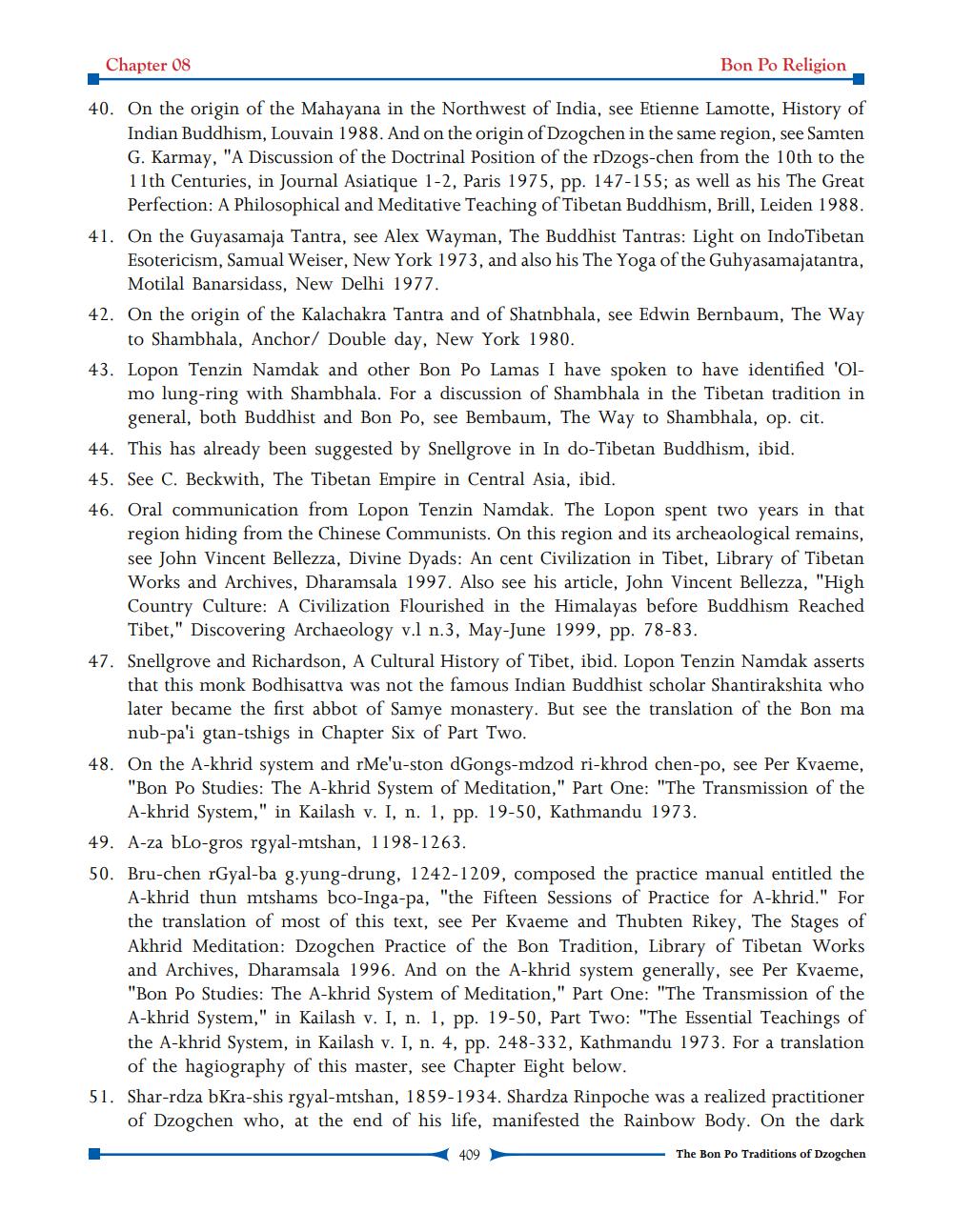________________
Chapter 08
Bon Po Religion
40. On the origin of the Mahayana in the Northwest of India, see Etienne Lamotte, History of Indian Buddhism, Louvain 1988. And on the origin of Dzogchen in the same region, see Samten G. Karmay, "A Discussion of the Doctrinal Position of the rDzogs-chen from the 10th to the 11th Centuries, in Journal Asiatique 1-2, Paris 1975, pp. 147-155; as well as his The Great Perfection: A Philosophical and Meditative Teaching of Tibetan Buddhism, Brill, Leiden 1988. 41. On the Guyasamaja Tantra, see Alex Wayman, The Buddhist Tantras: Light on IndoTibetan Esotericism, Samual Weiser, New York 1973, and also his The Yoga of the Guhyasamajatantra, Motilal Banarsidass, New Delhi 1977.
42. On the origin of the Kalachakra Tantra and of Shatnbhala, see Edwin Bernbaum, The Way to Shambhala, Anchor/ Double day, New York 1980.
43. Lopon Tenzin Namdak and other Bon Po Lamas I have spoken to have identified 'Olmo lung-ring with Shambhala. For a discussion of Shambhala in the Tibetan tradition in general, both Buddhist and Bon Po, see Bembaum, The Way to Shambhala, op. cit. 44. This has already been suggested by Snellgrove in In do-Tibetan Buddhism, ibid. 45. See C. Beckwith, The Tibetan Empire in Central Asia, ibid.
46. Oral communication from Lopon Tenzin Namdak. The Lopon spent two years in that region hiding from the Chinese Communists. On this region and its archeaological remains, see John Vincent Bellezza, Divine Dyads: An cent Civilization in Tibet, Library of Tibetan Works and Archives, Dharamsala 1997. Also see his article, John Vincent Bellezza, "High Country Culture: A Civilization Flourished in the Himalayas before Buddhism Reached Tibet," Discovering Archaeology v.l n.3, May-June 1999, pp. 78-83.
47. Snellgrove and Richardson, A Cultural History of Tibet, ibid. Lopon Tenzin Namdak asserts that this monk Bodhisattva was not the famous Indian Buddhist scholar Shantirakshita who later became the first abbot of Samye monastery. But see the translation of the Bon ma nub-pa'i gtan-tshigs in Chapter Six of Part Two.
48. On the A-khrid system and rMe'u-ston dGongs-mdzod ri-khrod chen-po, see Per Kvaeme, "Bon Po Studies: The A-khrid System of Meditation," Part One: "The Transmission of the A-khrid System," in Kailash v. I, n. 1, pp. 19-50, Kathmandu 1973.
49. A-za blo-gros rgyal-mtshan, 1198-1263.
50. Bru-chen rGyal-ba g.yung-drung, 1242-1209, composed the practice manual entitled the A-khrid thun mishams bco-Inga-pa, "the Fifteen Sessions of Practice for A-khrid." For the translation of most of this text, see Per Kvaeme and Thubten Rikey, The Stages of Akhrid Meditation: Dzogchen Practice of the Bon Tradition, Library of Tibetan Works and Archives, Dharamsala 1996. And on the A-khrid system generally, see Per Kvaeme, "Bon Po Studies: The A-khrid System of Meditation," Part One: "The Transmission of the A-khrid System," in Kailash v. I, n. 1, pp. 19-50, Part Two: "The Essential Teachings of the A-khrid System, in Kailash v. I, n. 4, pp. 248-332, Kathmandu 1973. For a translation of the hagiography of this master, see Chapter Eight below.
51. Shar-rdza bKra-shis rgyal-mtshan, 1859-1934. Shardza Rinpoche was a realized practitioner of Dzogchen who, at the end of his life, manifested the Rainbow Body. On the dark The Bon Po Traditions of Dzogchen
409




